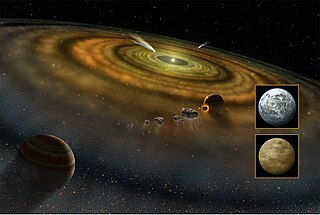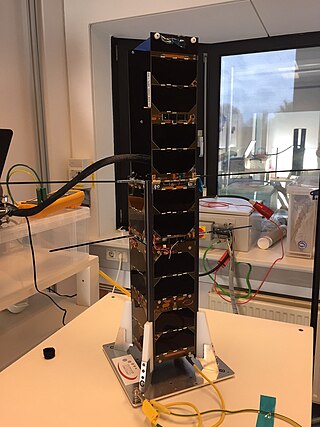Related Research Articles

Pictor is a constellation in the Southern Celestial Hemisphere, located between the star Canopus and the Large Magellanic Cloud. Its name is Latin for painter, and is an abbreviation of the older name Equuleus Pictoris. Normally represented as an easel, Pictor was named by Abbé Nicolas-Louis de Lacaille in the 18th century. The constellation's brightest star is Alpha Pictoris, a white main-sequence star around 97 light-years away from Earth. Pictor also hosts RR Pictoris, a cataclysmic variable star system that flared up as a nova, reaching apparent (visual) magnitude 1.2 in 1925 before fading into obscurity.

Pollux is the brightest star in the constellation of Gemini. It has the Bayer designation β Geminorum, which is Latinised to Beta Geminorum and abbreviated Beta Gem or β Gem. This is an orange-hued, evolved giant star located at a distance of 34 light-years, making it the closest giant to the Sun. Since 1943, the spectrum of this star has served as one of the stable anchor points by which other stars are classified. In 2006 an extrasolar planet was confirmed to be orbiting it.

Beta Pictoris is the second brightest star in the constellation Pictor. It is located 63.4 light-years (19.4 pc) from the Solar System, and is 1.75 times as massive and 8.7 times as luminous as the Sun. The Beta Pictoris system is very young, only 20 to 26 million years old, although it is already in the main sequence stage of its evolution. Beta Pictoris is the title member of the Beta Pictoris moving group, an association of young stars which share the same motion through space and have the same age.

AB Pictoris is a K-type star, approximately 163 light-years away in the constellation of Pictor. It has been identified as a member of the young Tucana–Horologium association. The star has also been classified as a BY Draconis variable. In 2005 it was announced that an astronomical object had been imaged in 2003 and 2004 close to and apparently in orbit around the star. Its mass suggests that it is at the borderline between being a brown dwarf or a planet.

Any planet is an extremely faint light source compared to its parent star. For example, a star like the Sun is about a billion times as bright as the reflected light from any of the planets orbiting it. In addition to the intrinsic difficulty of detecting such a faint light source, the light from the parent star causes a glare that washes it out. For those reasons, very few of the exoplanets reported as of April 2014 have been observed directly, with even fewer being resolved from their host star.
Pi Mensae, also known as HD 39091, is a yellow dwarf star in the constellation of Mensa. This star has a high proper motion. The apparent magnitude is 5.67, which can be visible to the naked eye in exceptionally dark, clear skies. It is nearly 60 light-years away. The star is slightly larger than the Sun in terms of mass, size, luminosity, temperature and metallicity, and is about 730 million years younger. It hosts three known planets.
HD 154345 is a star in the northern constellation of Hercules. With an apparent visual magnitude of +6.76 it is a challenge to view with the naked eye, but using binoculars it is an easy target. The distance to this star is 59.6 light years based on parallax, but it is drifting closer with a radial velocity of −47 km/s. At least one exoplanet is orbiting this star.
Gliese 86 is a K-type main-sequence star approximately 35 light-years away in the constellation of Eridanus. It has been confirmed that a white dwarf orbits the primary star. In 1998 the European Southern Observatory announced that an extrasolar planet was orbiting the star.
This page describes exoplanet orbital and physical parameters.
HD 16175 b is an exoplanet located approximately 195.7 light-years away in the constellation of Andromeda, orbiting the star HD 16175. This planet has a minimum mass 4.8 times that of Jupiter; the true mass was initially unknown since the inclination of the orbit was unknown. This planet orbits at about 2.2 astronomical units, taking 2.73 years to revolve around the star. The orbit of the planet is highly elliptical with an eccentricity of 0.64. In 2023, the inclination and true mass of HD 16175 b were determined via astrometry.

Beta Pictoris b (abbreviated as β Pic b) is an exoplanet orbiting the young debris disk A-type main sequence star Beta Pictoris located approximately 63 light-years (19.4 parsecs, or 6×1014 km) away from Earth in the constellation of Pictor. It has a mass around 13 Jupiter masses and a radius around 46% larger than Jupiter's. It orbits at 9 AU from Beta Pictoris, which is about 3.5 times farther than the orbit of Beta Pictoris c. It orbits close to the plane of the debris disk orbiting the star, with a low eccentricity and a period of 20–21 years.
HD 16760 is a binary star system approximately 227 light-years away in the constellation Perseus. The primary star HD 16760 is a G-type main sequence star similar to the Sun. The secondary, HIP 12635 is 1.521 magnitudes fainter and located at a separation of 14.6 arcseconds from the primary, corresponding to a physical separation of at least 660 AU. Announced in July 2009, HD 16760 has been confirmed to have a red dwarf orbiting it, formerly thought to be a brown dwarf or exoplanet.
HD 164604 is a single star in the southern constellation of Sagittarius constellation. It has the proper name Pincoya, as selected in the NameExoWorlds campaign by Chile, during the 100th anniversary of the IAU. Pincoya is a female water spirit from southern Chilean mythology who is said to bring drowned sailors to the Caleuche so that they can live in the afterlife. A 2015 survey ruled out the existence of any additional stellar companions at projected distances from 13 to 340 astronomical units. It is known to host a single super-Jupiter exoplanet.

An exocomet, or extrasolar comet, is a comet outside the Solar System, which includes rogue comets and comets that orbit stars other than the Sun. The first exocomets were detected in 1987 around Beta Pictoris, a very young A-type main-sequence star. There are now a total of 27 stars around which exocomets have been observed or suspected.

PZ Telescopii, also known as HD 174429 or simply PZ Tel, is a young star in the constellation Telescopium. Based on parallax measurements, it is located at a distance of 154 light-years from the Sun. The star is drifting closer with a radial velocity of −4 km/s. It is too faint to be visible to the naked eye and is classified as a BY Draconis variable that ranges in apparent visual magnitude from 8.33 down to 8.63 over a period of 22.581 hours. It is one of the closest and hence brightest pre-main-sequence stars to Earth.

51 Eridani is a star in the constellation Eridanus. It has an apparent magnitude of 5.22, meaning it is just visible to the unaided eye in suburban and rural skies. The primary star's absolute magnitude is 2.87. There is also a binary star named GJ 3305 which shares the same proper motion through space with it, making it overall a triple star system.

PicSat is a French observatory nanosatellite, designed to measure the transit of Beta Pictoris b, an exoplanet which orbits the star Beta Pictoris.
References
- 1 2 3 4 5 6 7 8 Lagrange, A.-M.; Meunier, Pascal Rubini; Keppler, Miriam; Galland, Franck; et al. (19 August 2019). "Evidence for an additional planet in the β Pictoris system". Nature Astronomy. 3 (12): 1135–1142. Bibcode:2019NatAs...3.1135L. doi:10.1038/s41550-019-0857-1. S2CID 202126059 . Retrieved 20 August 2019.
- 1 2 3 Feng, Fabo; Butler, R. Paul; et al. (August 2022). "3D Selection of 167 Substellar Companions to Nearby Stars". The Astrophysical Journal Supplement Series . 262 (21): 21. arXiv: 2208.12720 . Bibcode:2022ApJS..262...21F. doi:10.3847/1538-4365/ac7e57. S2CID 251864022.
- 1 2 3 4 5 Nowak, M.; et al. (6 October 2020). "Direct confirmation of the radial-velocity planet β Pictoris c". Astronomy & Astrophysics. 642: L2. arXiv: 2010.04442 . Bibcode:2020A&A...642L...2N. doi: 10.1051/0004-6361/202039039 . Retrieved 26 August 2020.
- 1 2 3 Lagrange, Anne-Marie (October 2020). Forveille, Thierry (ed.). "Unveiling the β Pictoris system, coupling high contrast imaging, interferometric, and radial velocity data". Astronomy & Astrophysics. EDP Sciences. 642: A18. Bibcode:2020A&A...642A..18L. doi: 10.1051/0004-6361/202038823 . ISSN 0004-6361 . Retrieved 7 October 2020.
- 1 2 Young, Monica (19 August 2019). "Beta Pic's New Planet, Jupiter's Fuzzy Core & An Ancient Star". Sky & Telescope . Retrieved 19 August 2019.
- ↑ Brandt, G. Mirek; Brandt, Timothy D.; Dupuy, Trent J.; Li, Yiting; Michalik, Daniel (2021). "Precise Dynamical Masses and Orbital Fits for β Pic b and β Pic C". The Astronomical Journal. 161 (4): 179. arXiv: 2011.06215 . Bibcode:2021AJ....161..179B. doi:10.3847/1538-3881/abdc2e. S2CID 226306610.
- ↑ Webb, R. A.; Bessell, M. S.; Song, Inseok; Zuckerman, B. (30 October 2001). "The β Pictoris Moving Group". The Astrophysical Journal Letters. 562 (1): L87–L90. Bibcode:2001ApJ...562L..87Z. doi: 10.1086/337968 . S2CID 120493760.
- ↑ Gray, R. O.; et al. (2006). "Contributions to the Nearby Stars (NStars) Project: Spectroscopy of Stars Earlier than M0 within 40 pc—The Southern Sample". The Astronomical Journal . 132 (1): 161–170. arXiv: astro-ph/0603770 . Bibcode:2006AJ....132..161G. doi:10.1086/504637. S2CID 250741593.
- ↑ "A second planet in the Beta Pictoris system". Nanowerk. 19 August 2019. Retrieved 20 August 2019.
- ↑ Starr, Michelle (2 October 2020). "Scientists Reveal First Direct Image of an Exoplanet Only 63 Light-Years Away". sciencealert.com. Retrieved 2 October 2020.
- ↑ Lacour, S.; et al. (2021). "The mass of β Pictoris c from β Pictoris b orbital motion". Astronomy & Astrophysics. 654: L2. arXiv: 2109.10671 . Bibcode:2021A&A...654L...2L. doi:10.1051/0004-6361/202141889. S2CID 237592885.